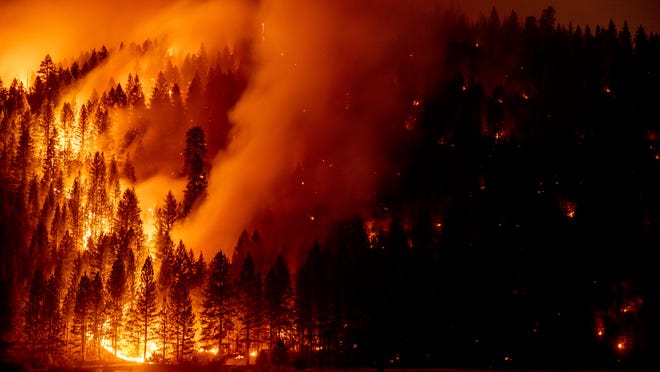
STOCKTON, Calif. — A rapidly expanding wildfire is approaching the outskirts of the Lake Tahoe basin and has become the nation's No. 1 priority for firefighting resources, the California Department of Forestry and Fire Protection said.
The Caldor Fire, which is only 10 days old, has exploded to nearly 108,000 acres and taken out 632 structures including more than 450 homes. It helped spur evacuations and, along with several blazes across the state, led to the closure of nine national forests. Nearly 18,000 properties were still in danger from the blaze, which was 9% contained as of Tuesday morning.
"It is knocking on the door to the Lake Tahoe basin," said Chief Thom Porter, director of CAL FIRE. "We have all efforts in place to keep it out of the basin but we do need to also be aware that is a possibility based on the way the fires have been burning."
Porter said the blaze was now the "No. 1 priority in the nation" for firefighting resources as it inched toward the South Lake Tahoe area, a popular vacation spot straddling the California-Nevada border known for its massive emerald-blue waters. More than 2,100 personnel, 22 helicopters, 50 fire crews and 200 fire engines are working to douse the fire.
A thick blanket of smoke filled the fire Tuesday, replacing blue skies with a grayish hue. The smoke partially obstructed the mountainous view and caused officials to alert those in the area to reduce time outdoors due to dangerous air quality.
Fire crews had hoped the towering granite cliffs separating the blaze from the Lake Tahoe basin would keep the fire from reaching the lake and the nearby communities, which includes a host of resorts. But, fire officials noted the blaze like others across the state had already been proving them wrong.
"We know this fire has done things that nobody could have predicted, but that’s how firefighting has been in the state this year," Eldorado National Forest Supervisor Chief Jeff Marsolais told the Associated Press on Sunday.
Highway 50, one of only two roads used to access the Lake Tahoe area from California, remained closed as the blaze continued to straddle the road. Fire crews worked to prevent flames from crossing the highway and spreading closer to the Lake Tahoe area.
Caldor Fire updates:117,704 acres, 9% containment; 'knocking on the door' to Tahoe Basin
More:Dixie Fire, Monument Fire, Antelope Fire latest updates: Northern California wildfires
Porter said he personally did not believe the fire would get into the basin but added he could be proved wrong, given the extraordinary behavior of current fires, such as the 1,142-square-mile Dixie Fire to the north in the Sierra-Cascades region.
"Mother Nature has taken over and taken fires like the Dixie to places that I never thought was possible," he said.
The Dixie Fire, burning for more than a month, was 41% contained after destroying at least 1,262 buildings, including 679 homes. It also mostly destroyed the community of Greenville, a small gold rush town about 100 miles northwest of the Lake Tahoe area, before becoming the second-largest wildfire in state history.
For the second day in a row, smoke from California’s massive fires kept schools closed in the Reno area of northern Nevada, affecting 67,000 students.
More:Wildfires are burning up trees meant to fight climate change: 'It’s definitely not working'
'Catastrophically destroyed': Dixie Fire wipes out California gold rush town of Greenville
Overall, more than 14,000 firefighters were battling a dozen major wildfires in California on Tuesday, according to Cal Fire.
As of Tuesday, the fires had burned nearly 1.3 million acres, which includes the Dixie Fire, the country's largest active wildfire. The fire has been burning for more than six weeks.
All told, there have been 6,714 wildfires to date in California, which have burned nearly 1.6 million acres — an area larger than Grand Canyon National Park, the California Department of Forestry and Fire Protection said.
Nationally, 92 large fires were burning in a dozen states, according to the National Interagency Fire Center, in Boise, Idaho.
Heat waves and historic drought tied to climate change have made wildfires harder to fight in the American West. Scientists have said climate change has made the region much warmer and drier in the past 30 years and will continue to make the weather more extreme and wildfires more frequent and destructive.
Some of the blazes in the West have burned through trees and forests set aside specifically to help curb climate change, areas large corporations buy credits within to offset their carbon footprint. In turn, the destroyed trees release the carbon they've absorbed into the atmosphere, compounding the very problem they were supposed to help.
Contributing: Brett McGinness, Reno Gazette-Journal; Jessica Skropanic and David Benda, Redding Record Searchlight; The Associated Press







